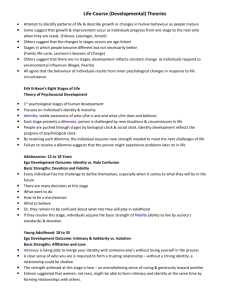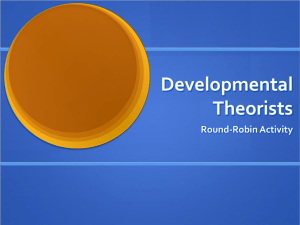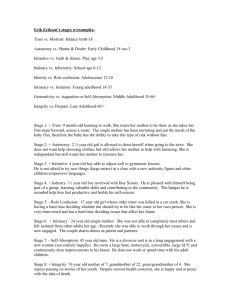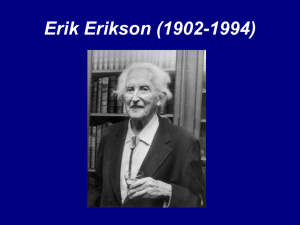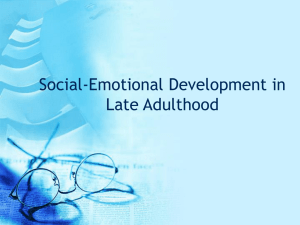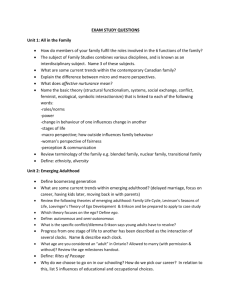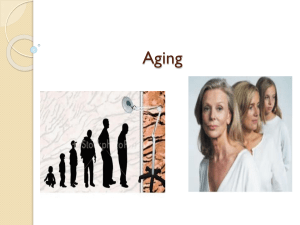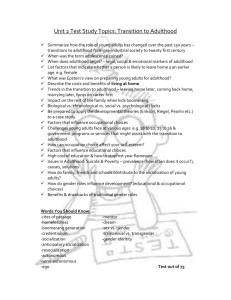Leonard Pearlin's Theory of Psychological Distress
advertisement
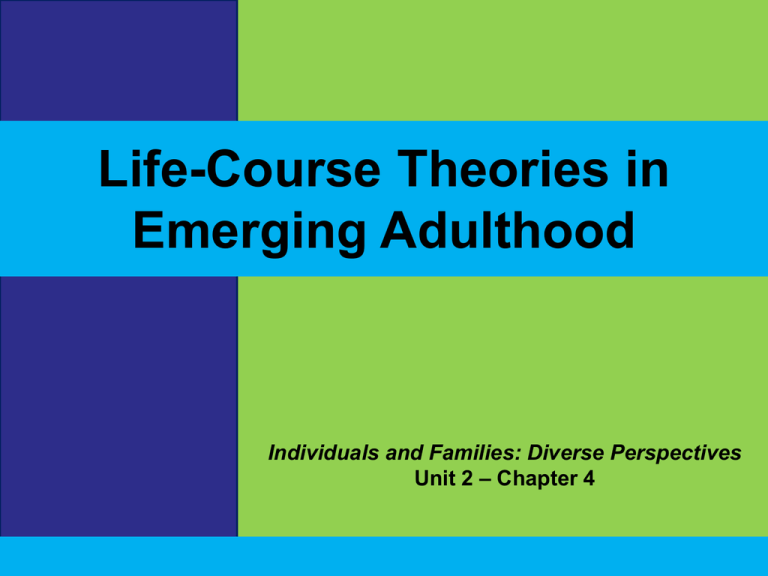
Life-Course Theories in Emerging Adulthood Individuals and Families: Diverse Perspectives Unit 2 – Chapter 4 Life-Course Theories • Describe changes in behaviour in age-graded patterns as individuals mature • Behaviour of individuals results from inner psychological changes in response to life circumstances • Sometimes called developmental theories • Life-course theories are created by analyzing the behaviours of large groups of individuals over a long period of time • Life-course theories began to appear in the 1950s • Life-course theories reflect the historical and cultural context in which the researchers conducted their studies Examples of Life-Course Theories Erik Erikson’s Eight Stages of Life Klaus Riegel’s Dimensions of Development Jane Loevinger’s Theory of Ego Development The Family Life-Cycle Framework Leonard Pearlin’s Theory of Psychological Distress Daniel Levinson’s Theory of the Seasons of Life Jeffrey Arnett’s Theory of Emerging Adulthood Erikson’s Eight Stages of Life • A series of eight stages in which an individual’s identity emerges and matures • Each stage presents a dilemma that must be overcome or the person might face difficulties later in life • Psychological and social clocks impact progression through stages • Dilemma during adolescence and young adulthood is defined as “identity versus role confusion” • Dilemma during young adulthood is “intimacy versus isolation” Identity vs. Role Confusion The task is to define who you are and who you will be in the future There are many decisions to be made during this time that will impact on the future Until they define who they are, adolescents and young adults will remain confused about the role they will play in adulthood By resolving the dilemma, individuals acquire the strength of fidelity—the ability to live by society’s standards Intimacy vs. Isolation Intimacy is being able to merge yourself with another without losing yourself Intimacy is the ability to trust a person enough to reveal your personal thoughts and feelings to them Includes relationships with all people— friends, dating partner, etc. Erikson believes that relationships would be shallow without an identity Klaus Riegel’s Dimensions of Development Four interrelated internal and external dimensions of development: • Internal psychological dimension: emotional maturity, independence, maturity of mental processes • Internal biological dimension: physical and sexual maturity • External cultural-sociological dimension: expectations and opportunities defined by society • External environmental dimension: physical, economic, and political environment in which one lives Klaus Riegel’s Dimensions of Development • Development occurs when a change in one dimension requires an adjustment in one or more of the other dimensions • Riegel’s theory integrates the physical and psychological dimensions with the external social and environmental dimensions Jane Loevinger’s Theory of Ego Development • Identified 10 stages in the formation of the ego • Full ego development is described as having an autonomous self • Loevinger sees the search for understanding of ego (or identity) as the centre of human development • Autonomous self: being self-reliant person who accepts oneself and others as multifaceted and unique Three stages of Loevinger’s Theory of Ego Development are relevant to the adolescent and young adult: • Conformist stage: view life in simple stereotypical ways • Self-aware stage: begin to understand and accept individual differences • Conscientious stage: able to appreciate others as individuals Jane Loevinger’s Theory of Ego Development • Loevinger believes individuals require a clear sense of themselves before they can develop intimate relationships with others • Progress from one stage to the next is determined by an individual’s psychological clock, not by chronological age or the social environment The Family Life-Cycle Framework • Describes early adulthood as the time when individuals are launched from their families of origin • Parents and youth must separate from one another = change in relationship/new roles • Family of Orientation Family of Procreation Three tasks of the young adult: • Forming an identity separate from family of origin • Making a commitment to career or workplace role • Developing intimate relationships with peers outside of family Leonard Pearlin’s Theory of Psychological Distress • Life course of continuous change required by distress • Distress: a stimulus that requires a psychological response • Young adults might experience distress as the individual acts to achieve their dreams formed in adolescence The path one takes is determined by four elements: • Individual characteristics • Range of skills an individual has for coping with stress • Availability of social support networks • Nature and timing of stress that requires a response Similarities in Life-Course Theories Because individuals change in response to similar external circumstances and stresses that affect their lives (the social clock) Individuals can anticipate and prepare for these role changes (e.g., by socializing) Cohort effect – changes in behaviour result from socialized responses to a common external social clock, not age-linked inner changes Daniel Levinson’s Theory of the Seasons of Life • Life course evolves through seasons lasting about 25 years each • From age 17–22, the adult season begins • Individuals prepare for an adult life structure by separating from family of origin Early Life Structure for Early Adulthood From age 22 to 28, individual enters the adult world—time for building one’s life structure: Forming a Dream and giving it a place in one’s life structure Forming an occupation Forming mentor relationships Forming love relationships, marriage, and family The Dream The Dream is the individual’s sense of self in the adult world and is the core of the life structure The nature of the Dream will vary but most include a combination of occupation, family, and community roles From ages 22 to 28, young adults build and test a preliminary life structure to attain their Dream Age-30 Transition From age 28–33, individuals re-evaluate the life structures formed in their 20s “Am I living my dream? If I am to change my life ... I must now make a start, for soon it will be too late.” This is a time to “get real” before “settling down” in their 30s Jeffrey Arnett’s Theory of Emerging Adulthood • Distinct stage in the life course between adolescence and adulthood • Arnett argues individuals from 18–25 years of age in industrialized countries are not yet adults but no longer adolescents • Emerging adults focus identity exploration in a variety of possible life directions in love, work, and worldviews Instability Move in and out of the parental home Have not achieved financial independence Individuals are semiautonomous Most young adults do not feel like they have reached adult status Opportunities for identity exploration separate from and prior to making decisions for adulthood Identity Exploration • Young adults focus their exploration in three areas: Love Work Worldviews • Seems that there is more time for exploration and the opportunity for experimentation now than in the past Consider the following: Divide into 8 groups Each group will examine one of the photo/figures in Chapter 4 (pages 99–111) Consider the questions presented with each photo. Refer to information from this presentation and the textbook when responding Share your responses with the class.
